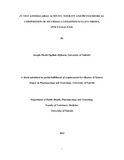| dc.description.abstract | The search for new, safe and efficacious agents against malaria is of precedence. This is
attributed to resistance of current chemotherapeutic agents to the malaria parasites and increased
toxicity of currently available antimalarial drugs. To address this challenge, increased efforts are
required aimed at discovering new agents against malaria. Natural products from plant
biodiversity have continued to play a pivotal role towards drug discovery against malaria and
other diseases. Despite the wide use of medicinal plants to control and treat conditions with
malaria-like symptoms, little has been done to evaluate their safety, efficacy and phytochemical
composition, to validate the claimed anecdotal efficacy.
The current study was designed to investigate in vivo antimalarial activity and efficacy, in vitro
cytotoxicity, in vivo acute toxicity and phytochemical composition of aqueous and organic crude
extracts from Securidaca longepedunculata Fresen. (Polygalacea). A four day suppressive
standard test was used to investigate in vivo anti-malarial activity of the crude extracts. The in
vitro cytotoxicity was evaluated using a tetrazolium salt MTT (3-[4.5-dimethylthiazol-2-yl]-2.5-
diphenyltetrazolium bromide) colorimetric method, based on reagent cleavage by mitochondrial
dehydrogenase in viable cells. The in vivo acute oral toxicity was carried out on healthy 6-8
weeks old female Swiss albino mice using the Organization for Economic Cooperation and
Development (OECD 423) guidelines. Standard methods were used for phytochemical screening.
The standard anti-malarial drug employed for positive control; chloroquine showed percentage
parasitaemia suppressions of 96.99% after 4 days of treatment. Chloroquine did not show any
significant difference (p>0.05) in comparison with that from the percentage parasitaemia
xv
suppression exhibited by the aqueous and organic root extract of S. longepedunculata after the 4
days treatment of mice infected with P. berghei. The highest level of clearance was observed in
chloroquine treated group, with percentage parasitaemia on day 4 as 0.68 ± 0.17 as compared to
22.58 ± 0.84 of the negative control group. S. longepedunculata root organic and aqueous crude
extracts equally demonstrated a good suppression of parasitaemia on day 4 with a with
percentage parasitaemia of 1.93 ± 0.37 and 2.78 ± 0.46 respectively. Both organic and aqueous
extracts were non-toxic at 2000 mg/kg of bdw i.e. LD50>2000 mg/kg. None of the extract tested
was potentially toxic to HEp-2 cell lines, CC50 > 100μg/ml. The following phytochemicals were
demonstrated to be present in the crude extracts: steroids, alkaloids, anthraquinones, flavonoids,
tannins, saponins and cardiac glycosides.
This study has demonstrated that the crude extracts are a potential source of a new class of
antimalarial drugs. The extracts have got very good antimalarial activity and are not toxic in vivo
mice model. This study recommends further work aimed at hit identification for antimalarial
activity through bioactivity guided fractionation, isolation and purification of compounds
responsible for the observed antimalarial activity. The purified and identified hits could be used
for lead development for antimalarial activity as well as biomarkers for standardization of S.
longepedunculata herbal preparations for use against malaria. This study recommends in vitro
testing of these extracts for their activity against P. falciparum in order to consider them as
potential sources for antimalarial drug development for human malaria. The study also
recommends elucidation of mechanisms of action and investigations of active compounds in
terms of structure-activity relationship with modifications of the structure to enhance efficacy. | en_US |
| dc.description.department | a
Department of Psychiatry, University of Nairobi, ; bDepartment of Mental Health, School of Medicine,
Moi University, Eldoret, Kenya | |

